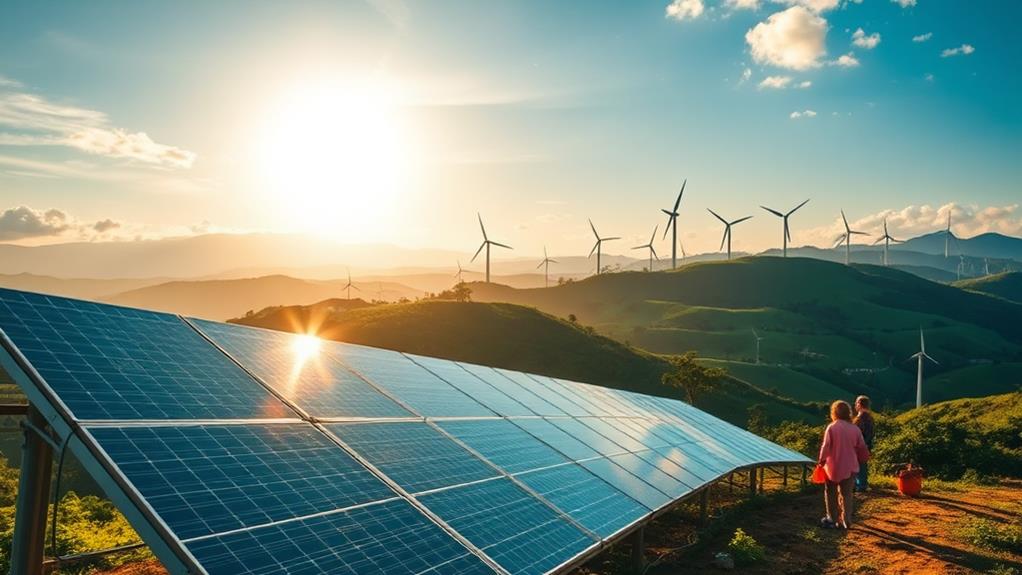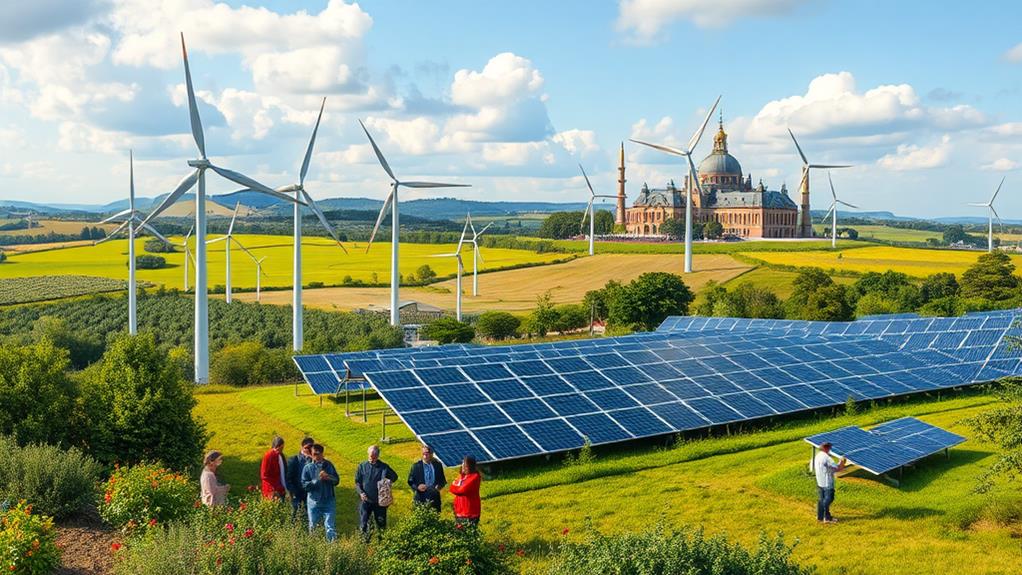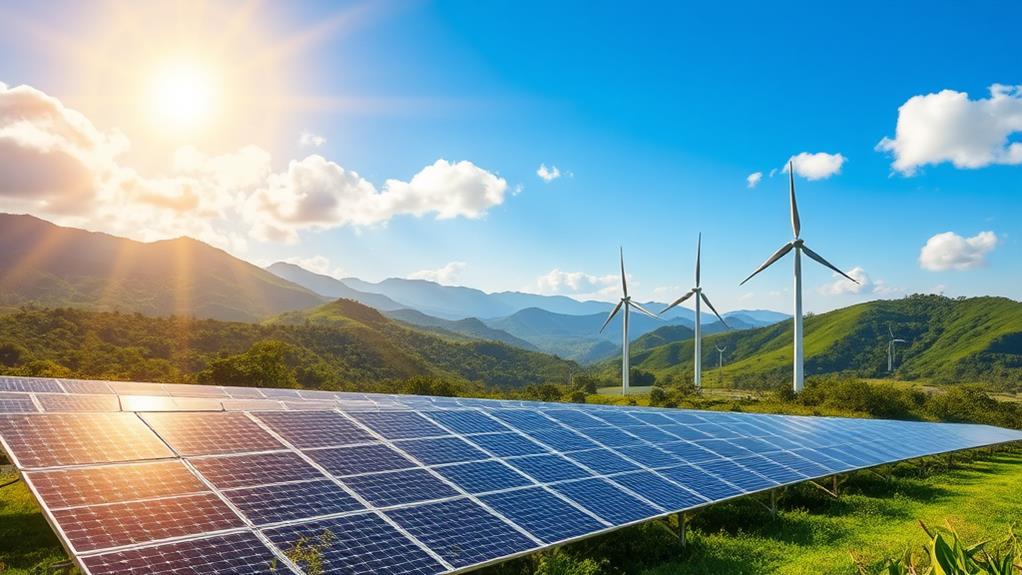Investing in renewable energy in the Philippines brings important economic benefits.
It can reduce the country's reliance on fossil fuel imports. This shift can help lower electricity rates, which are currently the highest in Asia.
Renewable energy projects create thousands of jobs. Studies show that these jobs offer better returns compared to jobs in fossil fuel industries.
Since 1977, the government could save over US$ 7 billion by investing in renewable energy.
Renewables also improve energy access for small and medium-sized businesses. This support helps these businesses grow and improves the quality of life for many people.
In summary, the advantages of renewable energy position the Philippines for sustainable growth in the energy sector and other areas.
Economic Gains From Renewable Energy

The economic gains from renewable energy in the Philippines are significant. By investing in renewable energy, the country can reduce its dependence on expensive fossil fuel imports. The Philippines has a potential of about 261,000 MW of renewable energy, which can help lower electricity rates that are currently the highest in Asia. This change would make energy more affordable for all citizens.
Additionally, renewable energy projects create jobs. For example, a 10 MW solar plant can employ around 1,000 workers during construction and provide about 100 permanent jobs afterward. This sector not only helps with job creation but also improves the investment climate, bringing in more money to the economy.
The financial benefits are also important. Since 1977, geothermal energy has saved the Philippine government over US$ 7 billion. Moreover, biomass and hydro technologies add millions in annual savings.
Job Creation in Renewable Sector
The renewable energy sector is a strong source of job creation. This sector creates many jobs because it requires a lot of workers. Here are some important facts:
- A 10 MW solar plant can hire about 1,000 workers during its construction and 100 workers for permanent roles afterward.
- Job creation can rise by 100% to 350% when we include jobs that are indirectly linked to the renewable energy sector.
- Jobs in renewable energy often offer better health benefits and higher wages compared to jobs in fossil fuels.
- The Philippines has a huge potential for renewable energy, estimated at 261,000 MW, which could lead to the creation of thousands of jobs in various industries.
Investing in renewable energy not only creates jobs but also supports the country's goals for a sustainable economy and energy independence.
As the renewable energy sector grows, it can greatly boost employment rates, leading to a stronger economy for the Philippines.
Financial Savings for Government

Renewable energy saves the Philippine government money. Since 1977, the government has saved over US$ 7 billion from geothermal energy. Additionally, the government saves US$ 96.9 million from biomass, US$ 65.9 million from hydro, US$ 8.5 million from solar, and US$ 29.5 million from wind each year.
These figures show the financial benefits of investing in renewable energy.
Switching to renewable energy can also lower the electricity rates in the Philippines, which are among the highest in Asia. This change can lead to savings for both the government and consumers.
The country has an untapped renewable energy potential of about 261,000 MW, indicating a chance for future savings and economic growth.
Relying on coal limits these savings and adds hidden costs due to pollution and health issues. By moving towards cleaner energy, the Philippine government can gain significant financial benefits and create a healthier environment.
This shift is essential for a successful energy transition.
Challenges to Renewable Energy Adoption
The Philippines can overcome challenges to adopting renewable energy by focusing on several key areas.
High Capital Costs are a major barrier. The initial expenses for renewable projects are often high, which can scare off potential investors. To tackle this, the government can offer financial incentives or subsidies that make it cheaper to start these projects.
Inadequate Regulatory Frameworks create uncertainty for developers. Current policies may not support renewable energy efforts effectively. By streamlining regulations, the government can provide clearer guidelines that encourage investment and development in renewable energy.
Technical Challenges also hinder progress. Issues with connecting renewable sources to the power grid and storing energy can complicate the shift to renewables. Upgrading the existing infrastructure and investing in smart grid technologies can improve the reliability of the energy system.
Public Resistance is another challenge. Many people have misconceptions about the reliability and cost-effectiveness of renewable energy.
To address this, increasing community awareness through education and providing clear information can help change public perception and support for renewable energy initiatives.
Policy Recommendations for Growth

To boost growth in the renewable energy sector, the Philippines should make important policy changes.
Canceling coal plant constructions is essential to shift funding toward clean energy sources.
Implementing the Renewable Energy Law fully will create a strong system that attracts investments and supports more renewable projects.
Focusing on local manufacturing of renewable energy products can create many jobs.
The renewable energy sector can produce 100-350% more jobs than fossil fuels. This makes it an important part of economic growth.
Also, enforcing the Green Energy Option Program (GEOP) is necessary. This program allows people and businesses to choose renewable energy, helping them become more independent and potentially lowering electricity costs.
Energy Access and Affordability
Expanding renewable energy in the Philippines helps improve energy access and affordability. About 2 million Filipinos don't have electricity. Renewable energy systems can provide electricity to these communities.
Here are four main benefits of this change:
- Lower Costs: Renewable energy can reduce electricity rates, which are the highest in Asia. This makes electricity more affordable for everyone.
- Stable Prices: As renewable energy becomes cheaper, it helps keep electricity prices stable. This reduces reliance on fossil fuels, which can have fluctuating prices.
- Support for Small Businesses: Access to affordable electricity helps small and medium-sized enterprises (SMEs). This lowers their operating costs and encourages economic growth.
- Better Quality of Life: Using renewable energy can lower household electricity bills. This leads to greater financial stability and improves life for many Filipinos.
These benefits show how renewable energy can enhance energy access and affordability, leading to a stronger economy.
Political Momentum for Transition

The Philippine government is making strong efforts to focus on renewable energy and move away from fossil fuels. They've declared a climate emergency, which shows their commitment to this change.
In 2020, the Department of Energy started a coal moratorium, stopping new coal-fired power plants. This is an important step toward using cleaner energy sources.
The Green Energy Option Program (GEOP) allows businesses to select 100% renewable energy. This program has received support from many major companies, showing that there's a strong push for renewable energy goals.
As elections approach, candidates are realizing that climate policy and renewable energy plans are important issues for voters.
Despite challenges like high costs and regulatory issues, there's a growing call for policy reforms to help adopt renewable energy faster.
This movement highlights the urgent need to tackle the climate emergency and also shows that the country can gain economic advantages from sustainable energy initiatives, leading to a greener future.
How is the Development of Wind Farms Contributing to the Economic Benefits of Renewable Energy in the Philippines?
The development of wind farms in the Philippines is playing a key role in the economic benefits of the renewable energy sector. The growth of the Philippine wind energy industry has led to job creation, increased investment, and reduced reliance on fossil fuels, ultimately leading to a more sustainable and prosperous economy.
Community Engagement and Advocacy
Community engagement and advocacy are important for promoting the economic benefits of renewable energy. By involving local communities, you can help them understand the economic opportunities that renewable energy can bring. Government spending on renewable energy creates three times more jobs than fossil fuels. This shows the potential for job creation in this sector.
Here are some key aspects of community engagement and advocacy:
- Increased Awareness: Educating communities about the economic benefits of renewable energy builds support for these initiatives. For example, workshops can help people learn about solar energy and its cost-saving potential.
- Policy Advocacy: Supporting the Renewable Energy Law can attract investments. This can lead to more jobs in the community. For instance, communities can advocate for local solar projects that create jobs and stimulate the economy.
- Local Projects: Projects like solar street lights and solar cold rooms help meet energy needs. These initiatives can also drive local change by providing jobs. For example, a community project installing solar street lights can employ local workers.
- Job Growth: Engaging communities can lead to a 100-350% increase in job creation in the renewable sector. This includes both direct and indirect jobs, such as manufacturing and installation roles.
Currently, around 2 million Filipinos lack access to electricity. Community-driven renewable energy projects can improve their quality of life and boost local economies.
Future Outlook for Renewable Energy

The future of renewable energy in the Philippines looks very bright. The country has the ability to produce around 261,000 MW from different renewable sources like solar, wind, and hydro. This capability opens up many options for energy solutions and helps the Philippines become a leader in the energy sector of Southeast Asia.
As the country moves towards using more renewable energy, it's expected to bring economic growth. This growth could lead to the creation of millions of jobs, with the renewable energy sector potentially generating up to 11 million jobs worldwide.
Switching to renewable energy may also help lower electricity rates, which are currently the highest in Asia. This change would make energy more affordable for everyone, including homes and businesses.
Important government actions, such as the Renewable Energy Act and various financial incentives, are essential in attracting investments. These investments will help build a stronger market for renewable energy technologies.
The Philippines aims for carbon neutrality by 2050. To achieve this goal, it's important to use the country's natural resources wisely. This strategy won't only help fight climate change but also improve energy independence and support sustainable development.
Questions and Answers
How Can Renewable Energy Benefit the Economy?
Renewable energy creates jobs. For example, solar and wind industries need workers for installation, maintenance, and manufacturing. This increase in employment helps the economy grow.
Renewable energy promotes energy independence. By using resources like sunlight and wind, countries can rely less on imported fossil fuels. This reduces vulnerability to price changes and supply disruptions.
Renewable energy provides investment opportunities. Investors are putting money into clean energy projects, which can lead to technological advancements and economic development. For instance, developing new solar panel technologies can create new markets and business ventures.
Renewable energy saves costs over time. While initial investments might be high, using renewable sources can lower energy bills. For example, homeowners with solar panels often see reduced electricity costs.
What Are the Benefits of Renewable Energy Development?
Renewable energy development creates jobs. For example, building solar farms and wind turbines requires workers for construction, maintenance, and operation. It also helps countries become less dependent on imported fuels. This means they can use their own energy sources, like solar or wind, instead of relying on other countries for oil or gas.
Renewable energy drives technology innovation. New technologies, such as advanced solar panels and more efficient wind turbines, are being developed to harness energy better. It supports environmental sustainability. By using renewable resources, we reduce pollution and conserve natural resources.
Renewable energy promotes rural electrification. Many rural areas can gain access to electricity through renewable sources, like solar mini-grids, which can be set up in places without existing power lines. This ensures everyone has access to energy. Overall, renewable energy contributes to a stronger and more sustainable economy.
What Is the Target of Renewable Energy in the Philippines?
The Philippines aims for 35% renewable energy by 2030 and 50% by 2040. These targets are part of the country's effort to develop sustainable energy sources. The government offers incentives and policies to encourage the growth of renewable energy. For example, solar, wind, and hydroelectric power projects can attract investments from businesses and individuals. These efforts not only support the environment but also create job opportunities in the renewable energy sector.
Why Has Renewable Energy the Potential to Power the Philippines Future?
Renewable energy has the potential to power the Philippines' future. Solar energy is abundant in the country, with many sunny days each year. For example, solar panels can be installed on rooftops to generate electricity for homes. Wind power can be harnessed in areas with strong winds, like in Ilocos Norte, where wind farms produce clean energy. Hydroelectric power comes from rivers and dams, such as the Angat Dam, which generates electricity from flowing water. Geothermal resources are also available, as the Philippines is located along the Pacific Ring of Fire, allowing access to steam from the Earth to generate power. Lastly, biomass can be used by converting organic materials, like agricultural waste, into energy. These renewable sources provide sustainable and clean energy, helping to stabilize costs and improve energy security for the Philippines.